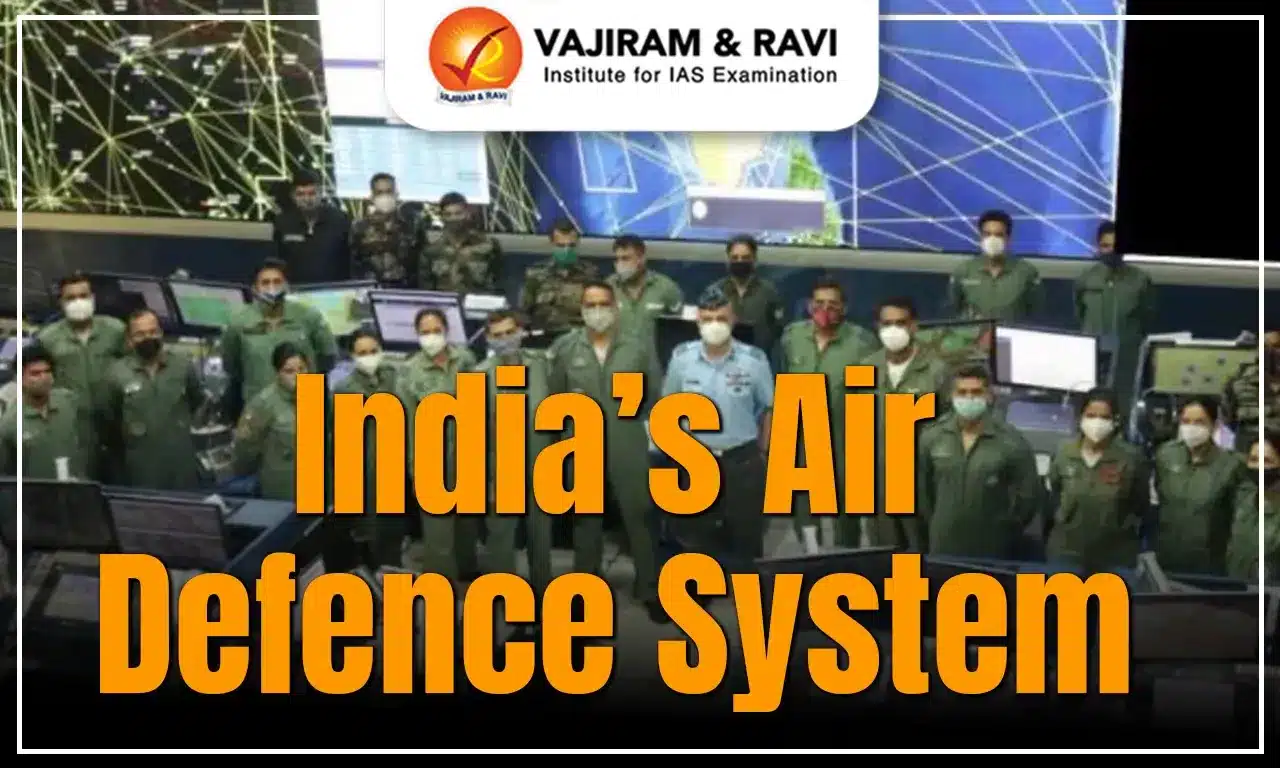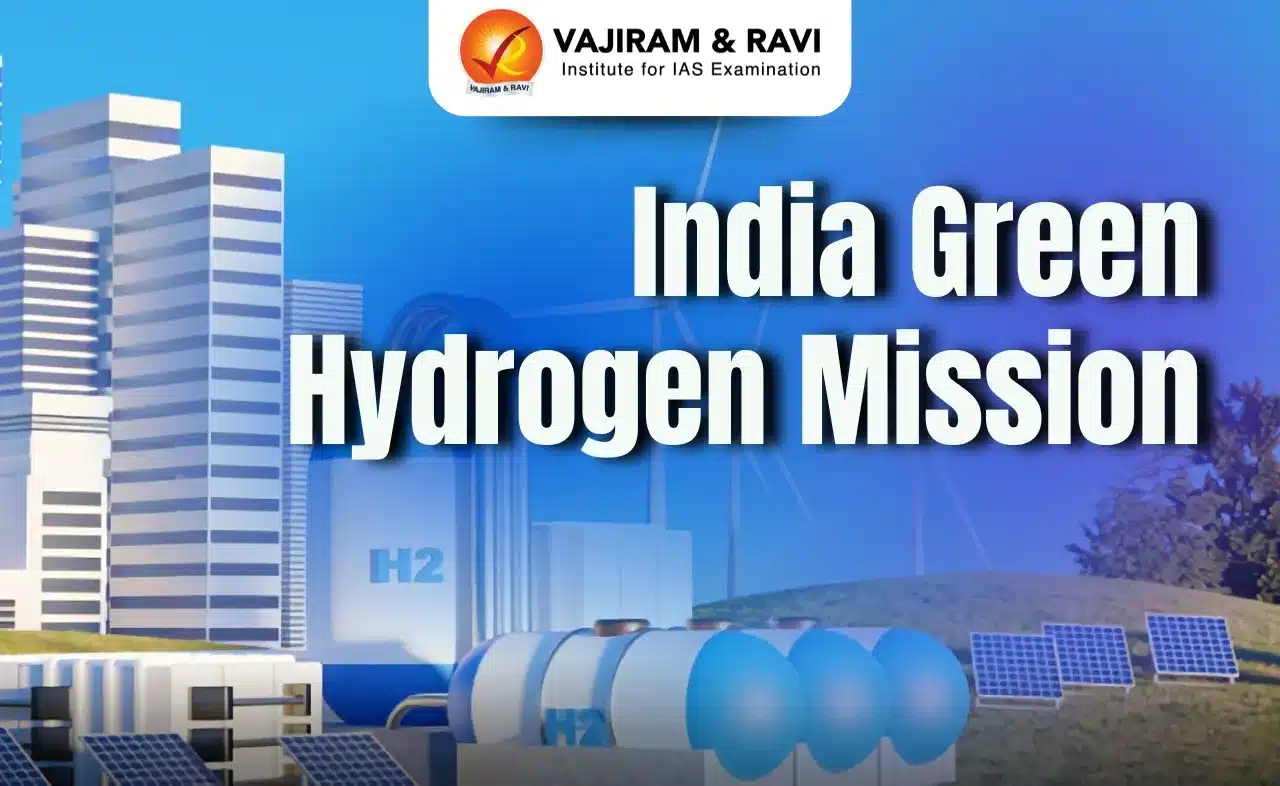What’s in Today’s Article?
- India’s Air Defence System Latest News
- The IAF’s Integrated Air Command and Control System (IACCS)
- The Army’s Akashteer System
- Multilayered Air Defence Umbrella
- Future of IACCS
- India’s Air Defence System FAQs
India’s Air Defence System Latest News
- During a media briefing on Operation Sindoor, the IAF showcased its Integrated Air Command and Control System (IACCS), which provides a real-time feed of India’s air defence operations.
- This system integrates radar, control centres, fighter jets, and ground-based defences to protect against aerial threats like enemy aircraft, drones, and missiles.

The IAF’s Integrated Air Command and Control System (IACCS)
- IACCS is an automated command and control system developed by Bharat Electronics Limited (BEL) for the Indian Air Force.
- It integrates data from various air defence sources, including ground and airborne radars, civilian radar systems, communication nodes, and command centres.
Real-Time Situational Awareness
- The system provides real-time updates and a consolidated dataset to commanders at multiple levels.
- This ensures comprehensive situational awareness during air operations and enhances decision-making in response to aerial threats.
Command Structure and Execution
- IACCS supports central control with decentralised execution, enabling swift identification and response to threats.
- It helps reduce reaction time and allows commanders to deploy air defence assets effectively.
Enhanced Airspace Management
- Overlapping radar and radio coverage within IACCS ensures efficient airspace monitoring and reduces system redundancy, leading to better coordination and control of air defence operations.
The Army’s Akashteer System
- Akashteer is the Indian Army’s air defence control and reporting system, designed to connect and coordinate its air defence units.
- It enables monitoring of low-level airspace over battle zones and controls ground-based air defence weapon systems.
Development
- Akashteer has been developed by Bharat Electronics Limited (BEL).
Integration with IAF Systems
- Currently operating on a smaller scale, Akashteer is being integrated with the Indian Air Force’s IACCS to ensure seamless coordination between Army and Air Force air defence operations.
Multilayered Air Defence Umbrella
- The Indian military employs a multi-layered air defence system, combining various assets to detect and neutralise aerial threats at different ranges and altitudes.
Key Components
- Point Defence: Includes low-level air defence guns and shoulder-fired weapons.
- Aerial Defence: Comprises fighter aircraft and long-range missiles.
- Surveillance Grid: Utilises ground-based radars and airborne systems like (Airborne Warning and Control System) and AEW&C (Airborne Early Warning & Control) Systems, all integrated into the IACCS for real-time tracking and interception.
Four Defence Layers Explained
- Layer 1: Counter-drone systems and MANPADS(Man-Portable Air Defence Systems).
- Layer 2: Point air defence and short-range surface-to-air missiles (SR-SAM).
- Layer 3: Medium-range surface-to-air missiles (MR-SAM).
- Layer 4: Long-range surface-to-air missiles (LR-SAM).
Future of IACCS
- Expanded Integration of Defence Assets
- The IAF has bolstered its air defence by deploying more radars and Surface to Air Guided Weapon (SAGW) systems, all integrated into the IACCS network at key sensitive bases.
- Towards Tri-Service Coordination
- With the increasing complexity of modern warfare, IACCS will be pivotal in integrating air defence assets across the Army, Navy, and Air Force for a unified and coordinated response.
- Embracing Advanced Technologies
- Future upgrades to IACCS will incorporate cutting-edge technologies like artificial intelligence for real-time threat analysis and enhanced situational awareness.
India’s Air Defence System FAQs
Q1. What is IACCS in India’s defence system?
Ans. IACCS is an automated air command and control system integrating radar, aircraft, and defences for real-time situational awareness.
Q2. What does Akashteer system do?
Ans. Akashteer links Army’s air defence units, enabling control and coordination in low-level airspace during battlefield operations.
Q3. How does India manage air threats?
Ans. India uses a multilayered air defence setup, integrating drones, radars, missiles, and fighter jets to detect and neutralize threats.
Q4. What are the four layers of India’s air defence?
Ans. India’s air defence includes counter-drone systems, SR-SAMs, MR-SAMs, and LR-SAMs for full-range aerial threat coverage.
Q5. How will IACCS evolve in the future?
Ans. Future upgrades will integrate AI and expand tri-service coordination for faster, tech-driven responses to complex aerial threats.
Source: IE
Last updated on June, 2025
→ UPSC Notification 2025 was released on 22nd January 2025.
→ UPSC Prelims Result 2025 is out now for the CSE held on 25 May 2025.
→ UPSC Prelims Question Paper 2025 and Unofficial Prelims Answer Key 2025 are available now.
→ UPSC Calendar 2026 is released on 15th May, 2025.
→ The UPSC Vacancy 2025 were released 1129, out of which 979 were for UPSC CSE and remaining 150 are for UPSC IFoS.
→ UPSC Mains 2025 will be conducted on 22nd August 2025.
→ UPSC Prelims 2026 will be conducted on 24th May, 2026 & UPSC Mains 2026 will be conducted on 21st August 2026.
→ The UPSC Selection Process is of 3 stages-Prelims, Mains and Interview.
→ UPSC Result 2024 is released with latest UPSC Marksheet 2024. Check Now!
→ UPSC Toppers List 2024 is released now. Shakti Dubey is UPSC AIR 1 2024 Topper.
→ Also check Best IAS Coaching in Delhi
























